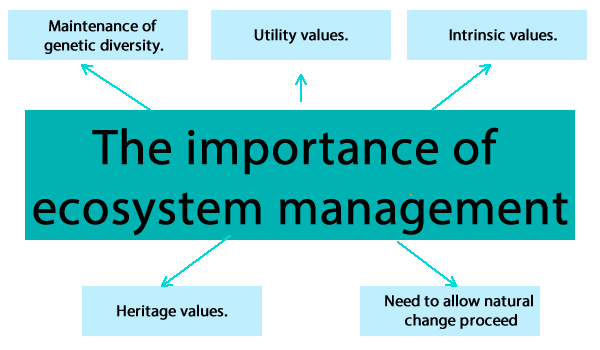The importance of ecosystem management and protection
Maintenance of genetic diversity
The full range of genetic diversity is known as biodiversity. Biodiversity provides the maximum amount of material for continued natural selection and evolution.
Example: Rhino
“Two species of rhino in Asia--Javan and Sumatran—are Critically Endangered. A subspecies of the Javan rhino was declared extinct in Vietnam in 2011. A small population of the Javan rhino still clings for survival on the Indonesian island of Java. The small size of the Javan rhino population is in itself a cause for concern. Low genetic diversity could make it hard for the species to remain viable.”
http://www.worldwildlife.org/species/rhino
Utilitarian values
Utility value is the ability of ecosystems to satisfy the economic wants of humans. Utility value has a measurable dollar value, and is often the only consideration taken into account when valuing natural environments.
“Human societies derive many essential goods from natural ecosystems, including seafood, game animals, fodder, fuelwood, timber and pharmaceutical products. These good represent important and familiar parts of the economy. What has been less appreciated until recently is that natural ecosystems also perform fundamental life-support services without which human civilisations would cease to thrive. These include the purification of air and water, detoxication and decomposition of wastes, regulation of climate, regeneration of soil fertility, and production and maintenance of biodiversity, from which key ingredients of our agricultural, pharmaceautical, and industrial enterprises are derived.”
Information from: http://www.esa.org/esa/wp-content/uploads/2013/03/issue2.pdf
Intrinsic values
The intrinsic value refers to the inherent ecological values that a place possesses. These may include aesthetic value, the right of species for existence
Aesthetics refers to the way people respond to the environment. It includes the way people interact with a place through their senses and the emotions they experience. Ecosystems can also have a social value. They can help people relax and undertake activities that help to maintain a healthy lifestyle and social interactions. People are able to undertake activities such as swimming, kayaking, bushwalking, etc.
Heritage values
Ecosystems which have remained relatively unchanged for a long period of time provide us with a glimpse of what the past was like.
Example - Antarctica
Ecosystems in Antarctica can provide information dating back hundreds and thousands of years. This provides valuable scientific information about the Earth’s history (eg. climate data).
Example – the Tarkine
The Tarkine is a temperate rainforest area in Tasmania. It contains one of the world’s last remaining Gondwanic old-growth rainforests. It has cultural significance to indigenous groups who have inhabited that area for 10,000 years.
Need for unimpeded natural change
Extinction is a natural consequence of the adjustment process in seeking a dynamic equilibrium. However, the rate of human-induced extinctions has accelerated alarmingly, and the natural evolution of new species has been unable to keep pace.
Example: Galapagos Islands
The Galapagos Islands provides a unique study of the different ways that organism can evolve under different circumstances. For example the different species of tortoises and inches that were studied by Charles Darwin and contributed to his Origin of the Species.
| the_importance_of_ecosystem_management_and_protection.docx |

